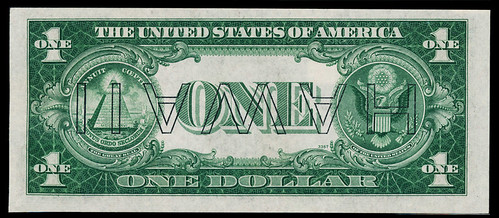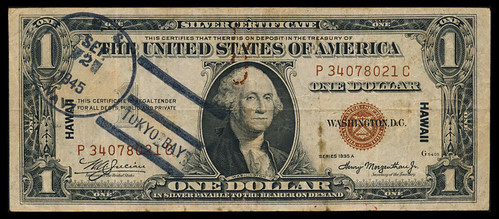
PREV ARTICLE
NEXT ARTICLE
FULL ISSUE
PREV FULL ISSUE
BOOK REVIEW: THE HAWAII OVERPRINT CURRENCY CATALOG
Jeremy Uota's new book on Hawaii overprint currency is a great resource for collectors of U.S. paper money or World War II numismatica. The 257-page The Hawaii Overprint Currency Catalog is available on Lulu.com for $74.95. While some of the basic information presented here is standard fare for U.S. Paper Money collectors, the level of detail shown here is available nowhere else in a single volume. The book opens with an introductory section describing the wartime orders surrounding currency hoarding and plans for a possible "substitute paper money" in preparation for a feared Japanese invasion. I learned something interesting early in the Introduction - that the planned money was called "Emmons money" after the Military Governor of the Territory of Hawaii, Lt. General Delos C. Emmons. The name was promoted by Major General Thomas H. Green, Executive to the Military Governor. A little kissing up to the boss, perhaps? In any event, the official name used in later documents was "U.S. Currency, Hawaiian Series". Green recounted an interesting story about the first Hawaiian Series notes to arrive: I obtained the first four one dollar bills of this Emmons money to be issued in Hawaii by exchanging it for four one dollar bills or regular currency. At my request, General Emmons endorsed his name on all four bills and I did likewise. I then sent all four bills to Admiral Nimitz with the request that he endorse his name on all four bills, retain one for his scrap book and return the other three to me. Nimitz signed the notes, but returned all four to Green. So where are these notes today? I reviewed the Short Snorter section for notes signed by these three individuals, but found no record of them. I asked Jeremy Uota, who writes: I too would like to find those notes. Nimitz autographed notes are available. Emmons and Green are lesser known in military history and don't show up in descriptions even if they signed a note. About $200 million in normal U.S. currency was collected in exchange for the new notes. The collected currency was burned in the Nuuanu Mortuary crematorium. Uota writes: "It is difficult to comprehend how many Hawaii national bank notes and other rarities were incinerated." Another thing I learned about the Hawaiian overprint currency was that it was also used as an invasion currency in the Pacific Theater, and was used to pay troops on Midway island and elsewhere in the Pacific.

Inverted overprint Other sections discuss the design of the notes and the various features making them distinct from regular U.S. currency. Plate layout, star notes and other varieties are discussed. Page 41 is a checklist of the major series and known check letter pairs. The core of the book are chapters on each of the four official print run denominations, $1, $5, $10 and $20. Each chapter is well illustrated, showing multiple examples of various check letter combinations. Another major section discusses the printing process and error notes. Pages 134-135 hold a handy guide to overprint variations. Another interesting section titled "Eclectic usages" covers short snorters, stamped, cancelled and dated Hawaii notes. (Short snorters were notes signed by a number of people, often taped together in lengthwise rolls as souveniers).

V-J date cancellation Many thanks to Jeremy Uota for providing me a review copy and electronic versions of the images shown here. This is a nice book that pulls together information and images from many disparate sources into a useful format for collectors and students of the series. Jeremy Uota adds: This study would not be possible without the contributions of Peter Huntoon, Don Medcalf, and Jim Simek.

HONOLULU fantasy note To read the earlier E-Sylum article, see: NEW BOOK: THE HAWAII OVERPRINT CURRENCY CATALOG (www.coinbooks.org/esylum_v15n51a03.html)
A message from Dave Bowers…
Mark your calendar! Tuesday, January 29, 2013 Internet-Only Sale Selections from the Steve Tanenbaum Collection of 1867-1876 Shell Cards Among the rarest, most interesting, and most significant specialties within 19th century American numismatics are shell cards. These are metal encasements somewhat like encased postage stamps in concept. Most are in the range of 34 to 39 cm, or the size of American double eagles and Liberty Seated dollars. In fact, many of these have these coin motifs. Others have a circular mirror on one side—intended to have the recipient keep the shell card is it remained useful. Otherwise, trade tokens and related exonumia were apt to be discarded. The other side has the advertisement of a merchant, service, or product. Some of these are in embossed brass, as in the manner of encased postage stamps, while others are printed circular thin cardboard discs, usually in color. These were a passion for the late Steve Tanenbaum, and he spent over 40 years collecting them—in the process forming the largest such collection ever. Part 2 will be offered in a forthcoming Stack’s Bowers Galleries sale, probably in connection with our official auction for the Whitman Coins & Collectibles Expo in Baltimore in June. As a reality check, the largest other collection known to me is that of the American Numismatic Society and comprises about 100 pieces. A “great collection” of shell cards would be doing well to have as many as 50! The collection is NOW on line at the Stack’s Bowers Galleries website. Bids are being accepted now and will be until the closing on Monday, January 29. The shell cards are lots 14,000 to 14,104. No comparable offering has taken place in the past century! As there is no reference book at all on this subject (imagine that!), I am in the process of creating one. It will be color-illustrated, on fine paper, and will have all of the information I can find. I am not ready to announce a publication date (in that way I can’t possibly be late!), but it is about 80% done. A visit to the American Numismatic Society is in the offing so I can capture information on any varieties unknown to me. When the book is ready I or the publisher will make advance announcements. Likely, the press run will be limited. I invite you to visit the Stack’s Bowers Galleries website, read the introductory material I prepared—about the history and other aspects—contemplate the listings, and bid for any that are of interest. In the meantime, my best wishes to you ![Shell cards 232792_01[1]](http://farm9.staticflickr.com/8091/8386073105_4a5727574d_t.jpg)
![Shell card 232792_02[1]](http://farm9.staticflickr.com/8211/8387158598_f1ab118335_t.jpg)
Wayne Homren, Editor The Numismatic Bibliomania Society is a non-profit organization promoting numismatic literature. See our web site at coinbooks.org. To submit items for publication in The E-Sylum, write to the Editor at this address: whomren@gmail.com To subscribe go to: https://my.binhost.com/lists/listinfo/esylum All Rights Reserved. NBS Home Page Contact the NBS webmaster 
|
